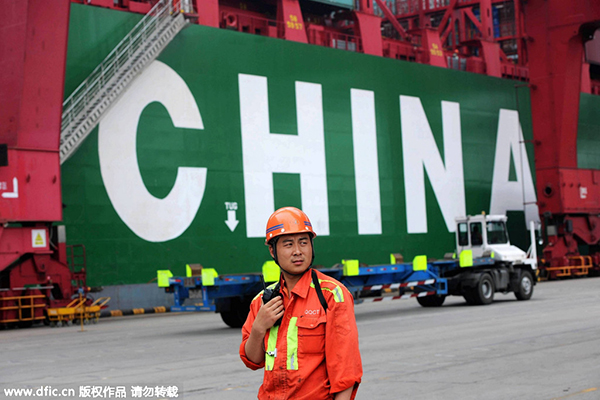Growing middle class globe-trotters sign of great potential
Updated: 2016-01-21 08:15
By Zhu Qiwen(China Daily)
|
|||||||||
 |
|
A stevedore works at Qingdao port in Shandong province, July 1, 2015. [Photo/IC] |
For those who are bearish on the Chinese economy, they need to square their assumptions of dim growth prospects for the world's second-largest economy with the seemingly unstoppable rise of outbound Chinese tourists.
If China was really heading for a hard landing, it is more than likely that its people should have generally been feeling the pinch and, as a precaution, postponed, if not abandoned, their planned overseas tours.
But that is not what seems to be happening.
Although the Chinese economy grew by only 6.9 percent last year, the slowest pace in 25 years, Chinese travelers have defied the headwinds to make around 120 million outbound trips in 2015, up 12 percent from the year before.
With China the top source of tourists worldwide for the fourth consecutive year, after more than a decade of double-digit growth, it is fairly reasonable to take that number as an important barometer of the country's rising living standards. Although much faster, the continuous surge in the number of outbound tourists, up from 10 million in 2000, is definitely in line with the 50-percent jump in the average income level in China between 2010 and 2015.
And according to a Bank of America Merrill Lynch forecast, the number of outbound Chinese travelers is expected to rise to around 174 million by 2019, spending about $264 billion annually.
Such a forecast is not a sure bet even after Chinese travelers spent $164.8 billion overseas in 2014, a fourfold increase over 2008. There are simply too many uncertainties concerning economic growth and financial stability around the world nowadays.
But it reflects the still-growing enthusiasm of Chinese consumers to travel more and shop more elsewhere.
Chinese tourists' contribution to other economies has become more evident than ever. For example, China sent a record 4.99 million visitors to Japan in 2015, more than double the previous year's figure. These Chinese tourists not only spent about 80 billion yuan ($12.16 billion) during their visits, helping to boost the Japanese economy, they also encouraged the Japanese government to consider raising its target of boosting the number of annual visitors from 20 million to 30 million by 2020.
Of course, those with a pessimistic view can shrug off the bullishness signaled by Chinese globe-trotters as not significant enough to justify strong confidence in the 10-trillion-dollar Chinese economy that is struggling with overcapacity in industrial sectors and overstock in the property market amid long-term challenges like a rapidly aging population.
And they may point to favorable conditions such as increased disposable incomes, extended national holidays, relaxed visa restrictions and the rising value of the Chinese currency as reasons for a large part of this spectacular growth story of Chinese outbound tourists for the better part of the past decade.
Nevertheless, they cannot turn a blind eye to the simple but complex fact that more and more Chinese people are travelling overseas to join an army of consumers deemed as the world's largest and most favorable spenders in spite of the increasingly loud talk of a possible hard landing at home.
Thus, second thoughts on the underlying changes taking place in the Chinese economy seem more than needed.
During a recent chat with one of my friends who spent a weeklong family tour of Japan last year, I could not help expressing my puzzlement at the ostensible contradiction between China's record number of overseas tourists and the scary stories about its economic slowdown.
But he mentioned his family's plan to visit Singapore during the coming Chinese Spring Festival. "When you've started, you know, it is hard to stop."
The author is a senior writer with China Daily.
zhuqiwen@chinadaily.com.cn
Related Stories
Chinese economy not in crisis: expert 2016-01-20 10:26
IMF: China has pivotal role in 2016 economy 2016-01-20 08:15
Internet adds spin to China's circular economy 2016-01-19 16:27
Officials deny China's graft fight has hindered economy 2016-01-15 17:43
Today's Top News
Inspectors to cover all of military
Britons embrace 'Super Thursday' elections
Campaign spreads Chinese cooking in the UK
Trump to aim all guns at Hillary Clinton
Labour set to take London after bitter campaign
Labour candidate favourite for London mayor
Fossil footprints bring dinosaurs to life
Buffett optimistic on China's economic transition
Hot Topics
Lunar probe , China growth forecasts, Emission rules get tougher, China seen through 'colored lens', International board,
Editor's Picks

|

|

|

|

|

|







